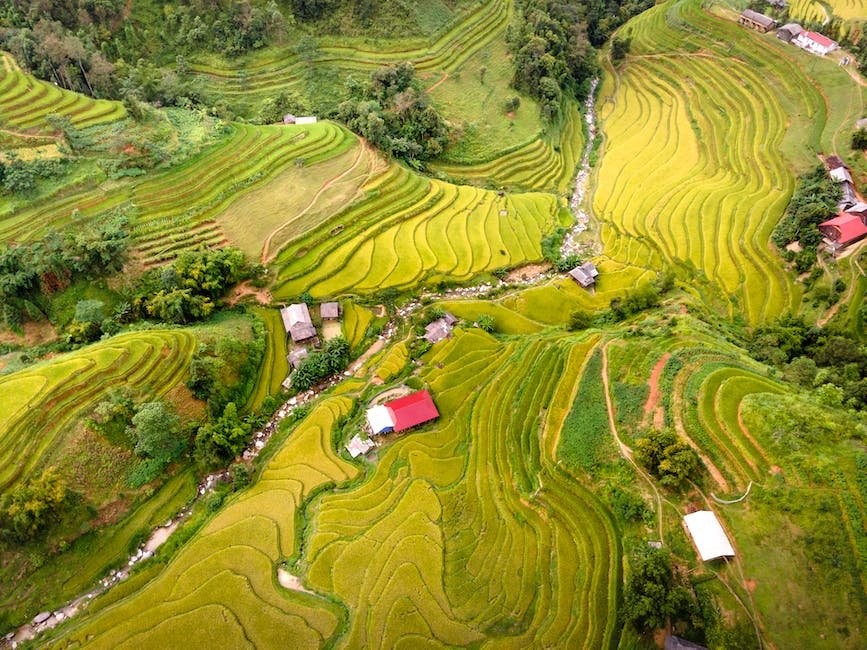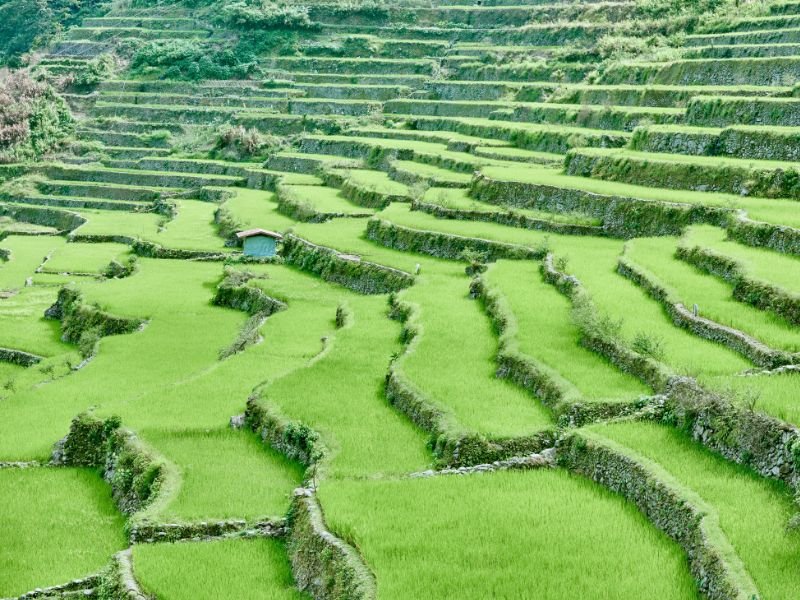In the Cordillera region of the Philippines, a series of rice terraces cover the mountainsides like a patchwork quilt. These UNESCO World Heritage Sites are some of the oldest and most beautiful in the world, and offer a unique opportunity to see traditional rice farming up close. The best way to experience the terraces is by trekking through them, and there are plenty of options for treks of all levels of difficulty. Whether you choose a easy day hike or a multi-day expedition, you’re sure to be amazed by the natural beauty of the Banaue-Batad Rice Terraces.
The Banaue-Batad Rice Terraces are a spectacular sight, and trekking through them is an amazing experience. The terraces are located in the mountains of the Philippines, and they were carved out of the mountainside by the Ifugao people centuries ago. Today, they are a popular tourist destination, and many people come here to hike and camp in the rice terraces. The best time to visit the rice terraces is between April and June, when the weather is dry and the rice is harvested.
Is Batad and Banaue Rice Terraces the same?
The Batad and Bangaan Rice Terraces are not called the Banaue Rice Terraces because they are not located within the boundaries of the Banaue municipality. However, they are still considered to be part of the Ifugao Rice Terraces, which were declared a National Cultural Treasure by the Philippine government in 1973. These rice terraces are located in the mountains of Ifugao province and are irrigated by an intricate system of canals and dams. They are a spectacular sight and are a popular tourist destination.
The Banaue Rice Terraces are a National Cultural Treasure of the Philippines, despite not being a UNESCO World Heritage site. The Terraces are commonly referred to by the locals in Banaue as the 8th Wonder of the World, and are definitely worth a visit if you find yourself in the area!
How do I get to Batad Rice Terraces
The Batad Rice Terraces are a beautiful sight, and to get there you need to take a bus bound for Banaue. There are two bus companies that operate a Manila to Banaue route – Coda Lines in Cubao, Quezon City and Ohayami Trans in Sampaloc, Manila. Make sure to bring a jacket or a small pillow to make yourself more comfortable on the 9-hour trip.
The Ifugao people are in danger of losing their unique heritage as they become increasingly acculturated. This process of acculturation is causing them to lose interest in their culture and the rice terraces. If this trend continues, the Ifugao people and their rice terraces will disappear.
Why is Batad Rice Terraces famous?
The rice terraces of the Philippine Ifugao are an impressive feat of engineering and a UNESCO World Heritage site. The terraces cover 10,360 square kilometers (about 4,000 square miles) of steep, mountainous terrain in a maze-like configuration. Some of the terraces are more than 2,000 years old. The rice terraces are irrigated by a complex system of canals and waterfalls and are still in use today. The terraces are a beautiful sight and a testimony to the skill and ingenuity of the Ifugao people.
The bus from Baguio to Banaue takes approximately 3 hours including transfers and departs at least three times a day. This bus is a convenient way to travel between the two cities and see the stunning scenery of the Philippine mountains.

Can you hike in Banaue Rice Terraces?
The hike around the terraces is not that long, the total is 215 kilometers, and it is doable in two days (although you can take it more slowly and finish it in three days), but hiking up and down the stone steep steps is not that easy as it could seem, and you should consider your level of fitness. Make sure you are drinking plenty of water and are rested before undertaking this hike. Also, watch your step on the uneven ground!
The Banaue Rice Terraces are some of the most breathtaking in the world. They are ancient, beautiful, and well-maintained. A hike through them is an unforgettable experience. The most popular hike is the 2-day hike, which takes you through the stunning Batad Rice Terraces. This is a must-do for any nature lover.
Why do people go to Banaue Rice Terraces
The Banaue rice terraces in the Philippines are a remarkable achievement in human history. Carved into the mountains of Ifugao some 2,000 years ago, these hand-hewn terraces are not only a beautiful sight to behold, but also provide a bountiful yield of rice for the region. It is a testament to what man can achieve when we work with nature instead of against it.
The rice terraces in Banaue are a UNESCO World Heritage site, and as such, there is a very small fee to visit them. Once you arrive in Banaue, head to the local tourism office where you can register and pay an environmental fee of 20 Php (about 04 USD). This will allow you to visit the rice terraces and appreciate their beauty!
What age is Banaue Rice Terraces for?
The Banaue Rice Terraces were carved into the mountains of Ifugao about 2,000 years ago by the ancestors of present day Philippines. It is said that they were built by hand and were used to plant rice. The rice terraces are an important part of Philippine history and culture, and are visited by tourists from all over the world.
Banaue is located in Ifugao Province in the Philippines.
Only fully vaccinated adults and minors are currently allowed to visit Banaue. Children below 12 years old are NOT yet allowed to enter the town.
Only tourists with advance booking/travel and accommodation arrangements are allowed to enter Banaue. Maximum cap of 100 tourists per day.
What is the current status of Banaue Rice Terraces
The Banaue rice terraces are a stunning example of human innovation and engineering. For centuries, the indigenous people of Ifugao province in the Philippines have managed these terraces, using them to cultivate rice. However, in recent years, the terraces have fallen into disuse, as the local population has moved away from agriculture.
Now, however, there is a movement to revive the Banaue rice terraces. Young farmers are returning to the area, and are working to restore the paddies to their former glory. With time and effort, the Banaue rice terraces will once again be a colourful collage of winding fields, a testament to the ingenuity of the human race.
The Banaue rice terraces are a system of irrigated rice terraces located in the mountains of north-central Luzon, Philippines. They were created more than 2,000 years ago by the Ifugao people and are collectively known as the Banaue rice terraces. The rice terraces are located in several villages, but the most famous and iconic ones are in the village of Banaue. The Banaue rice terraces are considered to be one of the most impressive engineering feats in human history, and they are a UNESCO World Heritage Site.
Is Banaue Rice Terraces still used today?
The Ifugao terraces are a remarkable feat of engineering and a UNESCO World Heritage Site. For centuries, the Ifugao people have cultivated rice on these terraces, which are carved into the mountainsides of northern Philippines.
However, in recent years, many of the Ifugao terraces have been abandoned, due to tough competition from commercial rice grown in the lowlands. Thanks to an increase in the price of rice, many of the terraces around Banaue are now actively worked again, with around 90% of them occupied.
The Ifugao terraces are a fascinating example of human ingenuity and traditional farming methods. It is encouraging to see that, despite the challenges, the Ifugao people are continuing to cultivate their rice terraces.
These 2000-year-old Banaue Rice Terraces are one of the most famous rice terraces in the world! The rice terraces are an engineering feat, since it’s largely built by hand into the mountain of Ifugao.
What is the best rice terraces in the world
The Honghe Hani Rice Terraces are a stunning example of an ancient rice terracing system that has been in place for over 1,300 years. The terraces are located in a UNESCO World Heritage site and span over 65 square miles. The rice terraces are a popular destination for photographers and Instagrammers, and are a truly unique sight to behold.
The Banaue Rice Terraces are a must-see when in the Philippines! These ancient terraces, built over 2000 years ago, are a true wonder of the world. Engineering experts have marveled at the feat of construction, and the terraces are now a UNESCO World Heritage Site. Be sure to take the time to visit this amazing place when in Ifugao province.
Wrap Up
The Banaue–Batad Rice Terraces are a group of rice paddies in the Ifugao Province of the Philippines that were carved into the mountainside over 2,000 years ago. The terraces are located in the Ifugao Rice Terraces World Heritage Site, which was inscribed by UNESCO in 1995. They are commonly referred to as the “Eighth Wonder of the World”.
The terraces are fed by an irrigation system of canals and dams that has been in use for over 2,000 years. They are located in an area that receives over 4 meters of rainfall per year. The Ifugao people grow a variety of crops on the terraces, including rice, bananas, sweet potatoes, and beans.
The Banaue–Batad Rice Terraces are a popular destination for trekkers and tourists. There are a number of trails thatlead through the terraces and provide stunning views of the rice paddies and the surrounding mountains.
The Banaue-Batad Rice Terraces are a beautiful and unique destination that is definitely worth a visit. The area is very picturesque and the trekking is an enjoyable experience. Be sure to bring plenty of water and snacks, as there are no convenience stores along the way.


